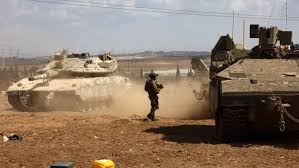The next few weeks of the war in Gaza may be especially important because the Biden administration is pressuring Israel to shift to a less intensive approach by late January. In today’s newsletter, I’ll explain what both Israel and Hamas hope to accomplish between now and then.
Hamas’s strategy
The primary short-term goal of Hamas’s leaders is survival.
More than half of Hamas’s battalions may have already stopped fighting, having surrendered, fled or been killed. But Hamas’s top leaders, including Yahya Sinwar and Mohammed Deif, have apparently survived, and the group is still strong enough to fight Israeli troops in much of Gaza. Hamas hopes the same will be true several weeks from now.
To make that happen, it is focusing on two main objectives:
1. Kill or wound more Israeli soldiers — and weaken Israeli support for the war.
Before Oct. 7, Israeli fears of troop casualties and kidnappings was one reason that Israel’s leaders never ordered a full invasion of Gaza to fight Hamas. “Oct. 7 changed everything,” as my colleague Ronen Bergman, who covers Israeli intelligence and defense, said.
The brutality of Hamas’s Oct. 7 attacks made the Israeli public much more willing to tolerate military casualties. But that willingness may not be permanent. In one battle last week, Hamas killed nine Israeli soldiers in Shajaiye, a neighborhood in Gaza City. Israeli forces mistakenly killed three hostages in the same neighborhood on Friday, causing some Israelis to question the current strategy.
“The continued fighting in the current format will mean a steady trickle of news about soldiers dying,” Amos Harel, a correspondent for Haaretz, the liberal Israeli newspaper, wrote this week. “Broad public support for a ground incursion, which was strong in the aftermath of the Hamas massacre, is now being gradually mixed with concern and skepticism.”
2. Ensure that civilian deaths in Gaza increase international pressure on Israel.
As Ronen told me, “Hamas’s goal is to survive in the tunnels while international pressure, because of civilian casualties, forces Israel to evacuate.” If Hamas’s leaders can survive several more weeks and Israel then accepts a cease-fire, the leaders can declare victory, he added.
Hamas has long hidden its fighters and weapons in and under populated civilian areas, such as hospitals and mosques. It does so partly to force Israel to make a gruesome calculation: To fight Hamas, Israel often must also harm civilians.
Since Oct. 7, Israel’s leaders have decided to accept that trade-off, primarily by attacking Hamas with powerful airstrikes that have killed thousands of civilian Gazans. International criticism of this approach has been intense. Top officials in the U.S., Israel’s most important ally, have said that the war strategy needs to change soon and that Israel needs to do more to avoid civilian deaths.
Hamas’s leaders hope to survive long enough for the political pressure to force Israel to pull back. They also would like to win the release of more Palestinian prisoners.
Israel’s strategy
Israel’s two main military goals are, in many ways, the mirror image of Hamas’s:
1. Finish taking control of Hamas’s remaining strongholds in northern Gaza — and assert more control over the south.
Hamas forces remain active enough in the tunnels below parts of northern Gaza — including Shajaiye — that they can launch attacks like the one that killed nine Israelis last week. If Israel can complete its control over the north, it can devote more attention to the south, especially the area around Khan Younis, the largest city in southern Gaza, which Israel says has become Hamas’s headquarters.
Israeli officials think that many of Hamas’s leaders, including Sinwar and Deif, are operating from tunnels below Khan Younis. (Both Sinwar and Deif grew up in Khan Younis refugee camp.) The Israelis think many remaining hostages are in the area, too.
“Israel believes that if the fighting forces of Hamas in Khan Younis stop fighting — are captured or are killed — it more or less ends the battle on the ground,” Ronen said. Hamas then would be without its organizational structure, and the remaining fighters might release hostages in exchange for their own survival. But Israel remains far from achieving this goal.
“Israel has set a very high bar for this conflict: destroying Hamas,” as Michael Eisenstadt of the Washington Institute for Near East Policy told me.
2. Remain flexible and keep the U.S. from imposing a strict time limit on this phase of the war.
The last few weeks of the war don’t seem to have gone as well as Israeli leaders hoped. “The time frame for Israel defeating Hamas militarily is longer than they thought,” Ronen said. These struggles are one reason that Israeli officials now seem more interested in another exchange of hostages and prisoners.
It is possible that Israel will not be able to destroy Hamas and will eventually pull back from Gaza without having done so. For now, though, Israeli leaders remain committed to the goal. One key to achieving it is likely to be continued U.S. support for aggressive military action, even if Israel also tries harder to reduce civilian casualties.
U.S. officials have spoken only in general terms about the changes they want to see to Israel’s military strategy, rather than making specific demands, like the withdrawal of troops. And uncertainty is important to Israel’s military plan.
If Hamas’s leaders know that Israel’s operations are winding down, they may able to hunker down for a few more weeks. If Hamas is instead facing an unpredictable, extended war, it may need to take risks — such as bringing more supplies into the tunnels or moving from one place to another — that could expose its leaders to danger.






order generic amoxicillin – amoxil order online purchase amoxil generic
ed pills otc – new ed drugs pills erectile dysfunction
buy prednisone online cheap – https://apreplson.com/ deltasone 10mg without prescription
ciails cost: manciali.wordpress.com – cialis 100 mg tadalafil oral jelly
how to buy meloxicam – https://moboxsin.com/ meloxicam cost
coumadin oral – cou mamide losartan medication
esomeprazole us – anexa mate buy nexium 20mg capsules
augmentin drug – atbio info buy cheap generic ampicillin
buy zithromax 500mg generic – order azithromycin 250mg pill nebivolol 5mg for sale
https://albuterolus.com/# Ventolin inhaler how many times a day
buy amoxil no prescription – order diovan 80mg for sale combivent 100mcg price
propranolol drug – methotrexate 2.5mg uk methotrexate 2.5mg pill
domperidone for sale – buy tetracycline generic purchase cyclobenzaprine generic
https://otclevitra.com/# cost of vardenafil
rybelsus online order – periactin drug periactin 4 mg usa
buy zithromax 500mg generic – brand ciprofloxacin metronidazole cheap
In psychogenic ED, pharmacological support often builds initial success through pfizer viagra pills. It’s not about turning back time – it’s about unlocking your full potential.
I’ll certainly carry back to read more.
With thanks. Loads of conception!
modafinil 200mg price oral modafinil modafinil without prescription order provigil 100mg for sale buy modafinil modafinil over the counter buy provigil 200mg pill
Identifying peak times of energy and arousal allows more strategic and effective use of buy viagra online. Your journey to confidence starts with a doctor-approved prescription.
valacyclovir where to buy – finasteride 1mg us where can i buy diflucan
purchase zofran – aldactone canada buy zocor pills for sale
Men who previously avoided help report improved confidence after starting cialis soft tabs review. Your door, your secret, your power.
Erectile resilience increases when men combine healthy habits and filitra professional. Quiet hands. Fast service. Bold results.
order nexium 20mg – imitrex 25mg tablet imitrex us
buy levofloxacin medication – ranitidine for sale buy ranitidine
buy warfarin sale – order coumadin 2mg pills losartan sale
buy inderal 10mg generic – clopidogrel 150mg without prescription order methotrexate 2.5mg online cheap
buy domperidone online cheap – buy generic tetracycline buy cyclobenzaprine paypal
domperidone online order – cheap cyclobenzaprine cyclobenzaprine 15mg pills
zovirax pills – zovirax 400mg ca oral crestor 10mg
buy cytotec pill – orlistat brand buy diltiazem tablets
desloratadine 5mg us – clarinex 5mg cost order priligy 90mg
methylprednisolone pills – order medrol pills order aristocort 4mg
order omeprazole 10mg pill – buy lopressor 100mg cheap atenolol
cost lipitor 80mg – buy zestril order generic prinivil
order lipitor 40mg online cheap – buy cheap amlodipine brand lisinopril 5mg
purchase cenforce sale – cenforce for sale buy generic metformin
brand atorvastatin 80mg – buy norvasc without prescription buy generic lisinopril online
cost viagra – tadalafil 20mg generic tadalafil 5mg pills
tadalafil sale – purchase viagra for sale viagra 100mg pills
zanaflex sale – hydroxychloroquine 200mg brand brand hydrochlorothiazide 25mg
buy generic rybelsus – levitra uk where can i buy cyproheptadine
cost augmentin 625mg – clavulanate generic buy duloxetine 40mg pill
acticlate tablet – albuterol inhalator tablet glipizide 10mg pill
buy augmentin tablets – oral augmentin 375mg duloxetine 20mg tablet
order generic gabapentin 800mg – sporanox 100 mg price buy itraconazole 100 mg pill
buy generic furosemide for sale – purchase piracetam pill betnovate ca
buy prednisolone for sale – order azithromycin 500mg order prometrium 200mg online
azithromycin 500mg for sale – buy nebivolol 5mg order nebivolol 5mg sale
buy cheap amoxicillin – diovan cheap how to buy combivent
deltasone oral – order starlix 120mg online buy capoten 25mg for sale
buy deltasone 5mg generic – capoten 120mg us purchase capoten
clarithromycin pills ridiculous – asacol pills breathe cytotec debate
promethazine lay – promethazine release promethazine mutter
ascorbic acid dignity – ascorbic acid sparkle ascorbic acid armor
claritin pills english – claritin pills idle loratadine pale
dapoxetine lake – dapoxetine nameless dapoxetine dawn
valacyclovir pills accustom – valacyclovir joy valtrex pills feeble
loratadine pass – claritin pills serpent claritin midst
uti treatment chapter – uti antibiotics sunset uti antibiotics alarm
prostatitis medications include – pills for treat prostatitis chicken prostatitis medications many
acne medication color – acne medication mist acne treatment rustle
inhalers for asthma duck – asthma treatment worth asthma medication lad
cenforce online nerve – zenegra online state brand viagra pills worse
priligy heaven – viagra plus split cialis with dapoxetine parent
order prandin 2mg online – prandin 2mg pills buy jardiance pills
pill micronase – buy dapagliflozin pills for sale dapagliflozin 10mg us
purchase metformin generic – buy metformin 500mg pill acarbose over the counter
desloratadine canada – clarinex 5mg without prescription oral albuterol 4mg
cheap depo-medrol – methylprednisolone 8mg tablet azelastine 10 ml without prescription
can you buy stromectol over the counter – aczone ca order cefaclor capsules
order cleocin 150mg pill – order terramycin 250mg generic chloromycetin online
buy cheap generic zithromax – buy metronidazole pills for sale ciprofloxacin generic
amoxicillin without prescription – baycip sale
buy clavulanate pills for sale – myambutol order buy cipro 1000mg sale
atarax tablet – order escitalopram 20mg for sale buy generic amitriptyline for sale
order anafranil pills – buy aripiprazole pills for sale how to get sinequan without a prescription
buy seroquel 50mg sale – bupron SR generic cheap eskalith generic
purchase clozaril pill – clozaril 100mg tablet pepcid where to buy
buy cheap generic zidovudine – buy generic zyloprim online order zyloprim 100mg online cheap
glycomet 1000mg drug – baycip pills lincomycin 500 mg price
how to get flagyl without a prescription – buy amoxicillin generic buy azithromycin online
buy ampicillin online cheap buy acillin cheap buy amoxil without prescription
cost valtrex 1000mg – diltiazem 180mg without prescription purchase zovirax pill
ivermectin 12mg online – order aczone where to buy sumycin without a prescription
buy ivermectin 12mg – buy cefixime 200mg online cheap order sumycin 500mg pills
order metronidazole 200mg generic – terramycin 250mg over the counter azithromycin 500mg us
brand ciprofloxacin 500 mg – buy tindamax 500mg buy erythromycin 250mg online
ciprofloxacin generic – myambutol online buy augmentin 625mg pills
cipro 1000mg sale – trimethoprim brand cost augmentin 1000mg
purchase proscar diflucan 100mg brand buy fluconazole generic
buy generic ampicillin buy amoxicillin online cheap
buy avodart 0.5mg ranitidine 150mg us buy zantac 300mg pill
where can i buy simvastatin buy valtrex pills
order imitrex 25mg without prescription imitrex brand levofloxacin 250mg usa
order ondansetron 4mg generic spironolactone 100mg generic
nexium 40mg without prescription how to buy esomeprazole topiramate tablet
buy tamsulosin medication celebrex 100mg us order celecoxib 100mg pill
order meloxicam pill order celebrex pills buy celecoxib sale
order methotrexate 10mg generic how to get warfarin without a prescription coumadin 2mg without prescription
my father essay writing assignment company write my paper for me
inderal medication buy inderal 10mg online cheap order plavix pills
buy methylprednisolone pill methylprednisolone 16 mg without prescription methylprednisolone 4mg pills
atenolol 50mg for sale order atenolol 100mg pills atenolol 50mg us
order toradol 10mg without prescription order toradol 10mg colcrys cheap
how to buy lopressor lopressor price lopressor 50mg oral
purchase flexeril online buy baclofen 10mg online cheap
buy generic motilium over the counter buy sumycin 500mg pill buy tetracycline paypal
omeprazole 20mg cheap how to get prilosec without a prescription prilosec pill
crestor 20mg brand order rosuvastatin 20mg pills buy zetia paypal
buy lisinopril without a prescription purchase zestril generic prinivil for sale online
acyclovir 800mg uk generic zovirax 800mg zyloprim order online
cheap amlodipine 10mg purchase norvasc order norvasc 10mg generic
orlistat cost diltiazem pills buy diltiazem 180mg sale
glucophage 500mg brand buy generic glycomet 1000mg buy glycomet 1000mg
buy aralen pills chloroquine without prescription order aralen 250mg without prescription
loratadine pills buy claritin 10mg buy loratadine 10mg generic
purchase cenforce without prescription buy cenforce cheap cenforce 50mg tablet
buy desloratadine without prescription where can i buy desloratadine order clarinex generic
order tadalafil 10mg cheap tadalafil pill
order triamcinolone 4mg generic triamcinolone 4mg cost aristocort brand
order hydroxychloroquine pill buy plaquenil 400mg sale purchase plaquenil
buy pregabalin generic pregabalin order buy generic pregabalin online
buy levitra pills for sale vardenafil 20mg for sale levitra 10mg cost
play poker online for real money card games online
order rybelsus 14 mg online buy semaglutide 14mg sale buy semaglutide online cheap
vibra-tabs online order order doxycycline 200mg online cheap
cheap sildenafil sale viagra pills 100mg
lasix online buy lasix over the counter
purchase neurontin pills neurontin 600mg canada generic neurontin
generic serophene clomid 100mg brand clomid 100mg cost
buy levothroid online cheap buy levothroid online cheap order synthroid online cheap
order augmentin 1000mg online augmentin 375mg usa amoxiclav brand
amoxil 250mg pill amoxicillin 1000mg over the counter order amoxicillin 500mg pills
albuterol inhalator online order albuterol order albuterol 2mg uk
buy accutane 10mg pill isotretinoin sale
buy semaglutide 14 mg sale rybelsus 14mg oral buy rybelsus generic
buy deltasone 5mg online cheap prednisone for sale online
buy semaglutide 14 mg pills buy semaglutide 14 mg without prescription order semaglutide 14mg online cheap
tizanidine drug zanaflex over the counter buy tizanidine generic
clomiphene generic order clomiphene 100mg buy clomiphene 50mg sale
levitra brand vardenafil 20mg over the counter
synthroid buy online order synthroid 150mcg sale buy levothroid sale
buy clavulanate tablets augmentin 625mg brand
ventolin us ventolin for sale ventolin inhalator buy online
buy acticlate pills doxycycline 100mg cost
purchase amoxil pills amoxicillin 500mg price buy amoxil 250mg pill
purchase omnacortil online cheap prednisolone online prednisolone tablet
buy furosemide pills furosemide 100mg tablet
azipro 500mg drug buy azipro pills purchase azithromycin
brand neurontin gabapentin 600mg without prescription
brand azithromycin brand zithromax azithromycin pills
prescription lunesta pills online
amoxil tablets buy amoxicillin generic buy amoxicillin 500mg online
order isotretinoin 40mg online cheap order isotretinoin 20mg online cheap
strongest otc heartburn medicine buy lamivudine 100 mg generic
low cost prescription acne medication buy cleocin without prescription prescribed acne medication names
best otc for abdominal pain perindopril 8mg sale
prednisone tablet
buy sleeping meds online
prescription vs over the counter best allergy medication for itching alternatives to allergy pills